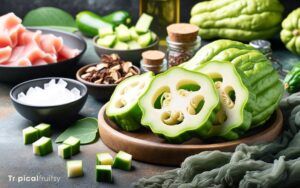How to Prepare Chayote for Diabetes? 6 Easy Steps!
To prepare chayote for diabetes management, opt for methods that preserve its low glycemic index. Start by washing the chayote thoroughly. You can either peel it or cook it with the skin on, as the skin is edible and contains fiber.
Cut the chayote in half and remove the seed if desired. Then, dice, slice, or chop the chayote according to your recipe.
Steaming, boiling, sautéing, or eating it raw in salads are all diabetic-friendly ways to enjoy chayote. Avoid deep-frying or preparing it with high-sugar sauces to keep it healthy for diabetes.
Chayote, also known as mirliton or chocho, is a low-calorie vegetable rich in fiber, antioxidants, and vitamins.
It’s an excellent addition to a diabetic diet due to its low glycemic index, which means it causes a slower increase in blood glucose levels.
When preparing chayote:
For instance, you can make a refreshing chayote salad by shredding raw chayote and adding lemon juice, olive oil, and a sprinkle of salt and pepper.
Incorporating chayote into a diabetes meal plan can add variety and nutrients while helping maintain blood sugar control due to its low glycemic properties.

Key Takeaway
Understanding Chayote’s Benefits
Chayote, a low-glycemic vegetable, offers numerous health advantages for individuals managing diabetes, including its ability to help regulate blood sugar levels.
Scientifically known as Sechium edule, chayote is part of the gourd family and is recognized for its minimal impact on postprandial glucose concentrations.
Its high fiber content contributes to a slower absorption of carbohydrates, thus preventing sudden spikes in blood sugar. Additionally, chayote is rich in antioxidants and vitamins such as vitamin C, which may further support metabolic health.
Considering its nutritional profile, incorporating chayote into a diabetic diet can be advantageous. With this foundational understanding of chayote’s health benefits, the focus now shifts to selecting the perfect chayote for optimal dietary inclusion.
Step 1: Selecting the Perfect Chayote
Commonly overlooked in the produce aisle, chayote should be firm and free of blemishes when selected for diabetic-friendly meals.
Choosing the right chayote involves several considerations to ensure not only nutritional value but also optimal flavor and texture.
When shopping for this versatile squash, keep in mind the following characteristics:
- Uniform color: A consistent green hue without significant spots or discolorations.
- Smooth skin: The surface should be unwrinkled, indicating freshness and proper maturity.
- Heft for size: It should feel relatively heavy for its size, which can be a sign of good hydration and flesh quality.
- No soft spots: Soft areas may suggest internal decay, compromising both taste and nutrient profile.
Selecting a high-quality chayote is the first step; next, we will delve into the proper chayote storage methods to maintain its freshness.
Step 2: Proper Chayote Storage Methods
To maintain the quality of chayote after purchase, store it in a cool, well-ventilated space away from direct sunlight.
Optimal preservation of chayote involves controlling temperature and humidity, as these factors significantly influence the shelf life and nutritional integrity of the vegetable.
Chayotes should ideally be kept at a temperature of 7-10°C (45-50°F) with moderate humidity. Refrigeration can extend freshness, but chayotes are susceptible to chilling injury if stored below 7°C for extended periods, leading to pitting and discoloration.
It is advisable to use perforated plastic bags to promote air circulation and prevent moisture accumulation, which can cause decay.
For prolonged storage, inspect chayotes regularly and remove any that show signs of spoilage to prevent it from affecting others.
Step 3: Washing and Peeling Techniques
Before cooking or consuming chayote, especially for individuals managing diabetes, it is essential to thoroughly wash and properly peel the vegetable to ensure it is clean and free from contaminants.
The following steps should be taken:
- Rinse the chayote under cold running water to remove any surface dirt or potential pesticides.
- Use a clean vegetable brush to gently scrub the skin, enhancing the removal of any residual substances.
- Dry the chayote with a clean towel to minimize the risk of slipping while peeling.
- Peel the chayote with a sharp vegetable peeler or knife, removing the outer skin to reduce exposure to any remaining impurities.
These preparatory measures are crucial for maintaining food safety and maximizing the health benefits for diabetes management.
Step 4: Cooking Methods for Chayote
Although chayote can be eaten raw, cooking it using methods such as steaming, boiling, or sautéing can enhance its flavor and make it more palatable for those managing diabetes.
Steaming preserves the nutrients and is considered a healthful cooking method that does not require the addition of fats or oils, which is favorable for maintaining a low-calorie diet.
Boiling can be employed but should be done sparingly to prevent the loss of water-soluble nutrients into the cooking water.
Sautéing with a small amount of healthy oil, such as olive or canola, can add taste while allowing the chayote to remain a low-glycemic-index food, suitable for blood glucose control.
Each method maintains the integrity of the chayote’s beneficial properties, making it a versatile ingredient in a diabetic-friendly diet.
Step 5: Chayote Recipes for Diabetics
Incorporating chayote into meal planning can offer a nutritious option for individuals managing diabetes due to its low glycemic index.
Recipes that emphasize diabetic-friendly cooking techniques can enhance the vegetable’s benefits, ensuring minimal impact on blood glucose levels.
The subsequent discussion will focus on specific preparations of chayote suitable for diabetic diets, leveraging its glycemic properties and versatility in the kitchen.
Low Glycemic Index Meals
Chayote’s low glycemic index makes it an excellent ingredient for diabetic-friendly recipes that help maintain stable blood sugar levels. Its versatility allows for inclusion in a variety of dishes, providing both nutritional benefits and culinary diversity.
When planning meals for individuals managing diabetes, chayote can be a central component due to its favorable glycemic profile.
Here are some recipe ideas that incorporate chayote:
- Chayote and black bean salad with a lime vinaigrette
- Sautéed chayote with garlic and herbs as a side dish
- Stuffed chayote with quinoa and vegetables
- Chayote soup with lean chicken and aromatic vegetables
These recipes highlight the adaptability of chayote in creating low glycemic index meals suitable for a diabetic diet.
Next, we will explore diabetic-friendly cooking techniques that can enhance the health benefits of chayote dishes.
Diabetic-Friendly Cooking Techniques
Utilizing diabetic-friendly cooking techniques can significantly enhance the health benefits of chayote-based dishes for those managing diabetes. Preparing chayote in a manner that preserves its low glycemic index is essential.
Steaming or sautéing in a small amount of olive oil are preferable methods, as they retain the phytonutrients and prevent unnecessary addition of carbohydrates or fats that could affect blood glucose levels.
Incorporating chayote into mixed dishes with other non-starchy vegetables, lean proteins, and whole grains can create balanced meals that support glycemic control.
When seasoning, opt for herbs and spices instead of salt or sugar-laden sauces, to reduce the risk of hypertension and hyperglycemia.
These practices contribute to the optimal nutritional profile of meals for individuals with diabetes.
Step 6: Monitoring Glycemic Response
During meal planning for individuals with diabetes, it is crucial to monitor the glycemic response to different foods, including chayote, to manage blood sugar levels effectively.
Understanding the impact of chayote on blood glucose can guide dietary choices and portion sizes.
To evaluate the glycemic response, consider the following:
- Blood Glucose Monitoring: Regularly check blood sugar levels before and after consuming chayote to observe individual responses.
- Glycemic Index (GI): Identify the GI of chayote and incorporate it into a low-GI meal plan.
- Portion Control: Adjust portions based on glycemic response and overall carbohydrate goals.
- Meal Composition: Combine chayote with protein and healthy fats to potentially lower the overall glycemic impact of the meal.
Incorporating these strategies ensures that chayote can be a healthful part of a diabetes-friendly diet.
Conclusion
In summary, chayote is a versatile and nutritious vegetable beneficial for individuals managing diabetes due to its low glycemic index and high fiber content. Optimal selection, storage, and preparation can maximize its health benefits.
Incorporating chayote into a diabetic diet through various cooking methods can aid in blood sugar regulation.
For instance, a study demonstrated that participants who included chayote in their diet experienced improved glycemic control, underscoring its potential role in diabetes management.






